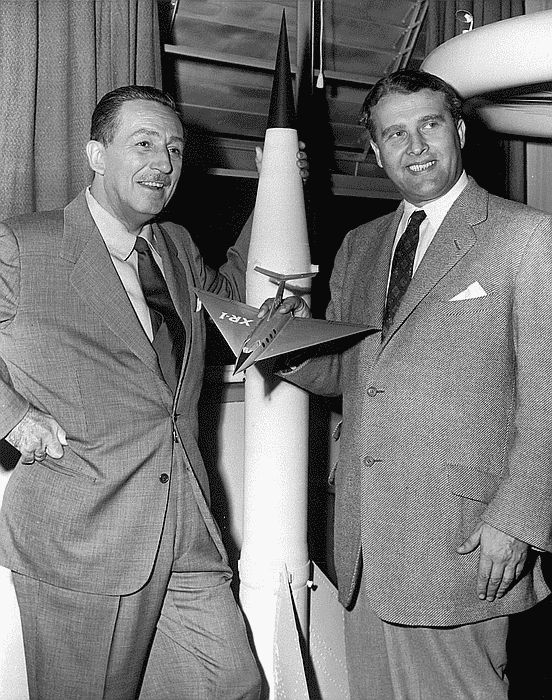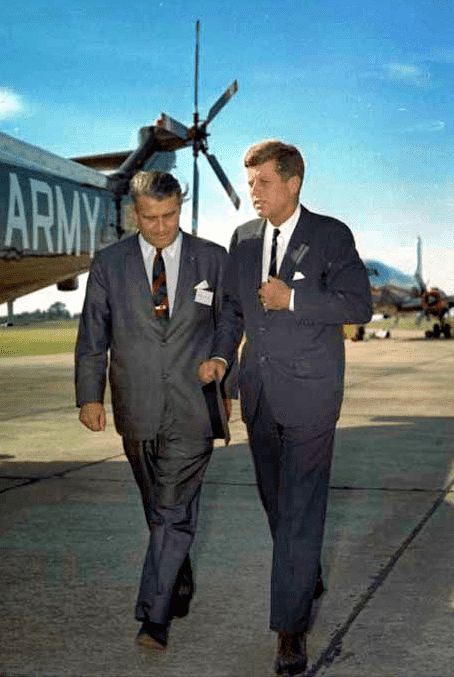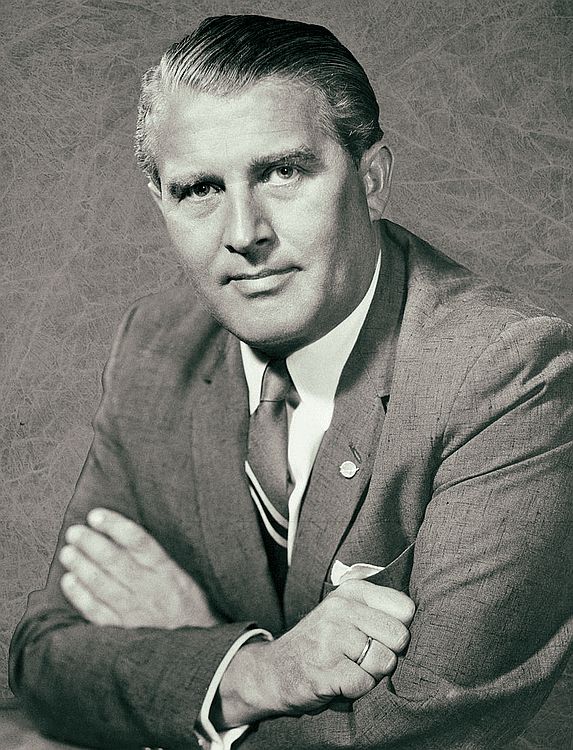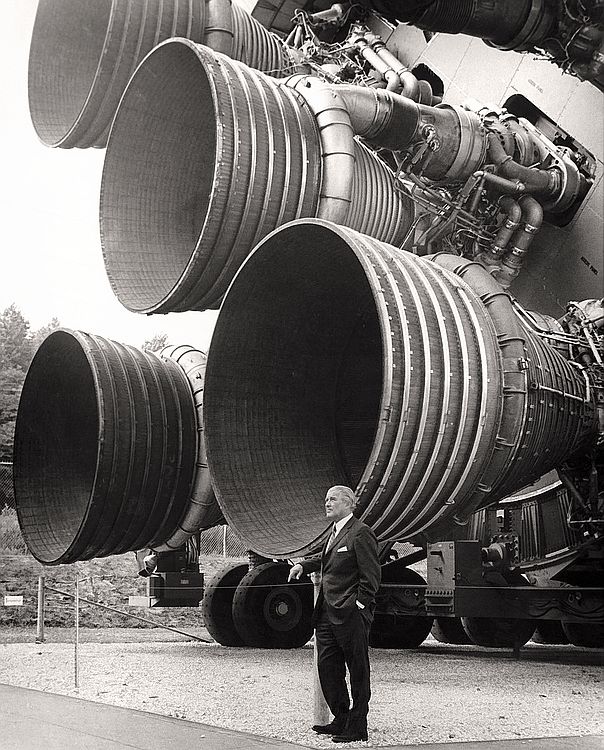Wernher Magnus Maximilian Freiherr von Braun (March 23 1912 – June 16 1977) was a German scientist and one of the leading figures in the development of rocket technology in Germany and the United States. In the United States, he is regarded as a hero of the space program. Before and during the Second World War, he worked on Nazi Germany's rocket program and made remarkable achievements. At the end of WW2 he entered the United States through a then-secret effort named Operation Paperclip.
Early life
He was born in Wirsitz, East Prussia (now Wyrzysk, Poland). Upon his Lutheran confirmation, his mother gave him a telescope. His interest in astronomy and the realm of space motivated him all his life. When Wirsitz became part of Poland in 1920, due to the Treaty of Versailles, his family, like many other German families, moved. The von Brauns found a new life in Berlin. He did not do well in physics and mathematics until he acquired a copy of the book Die Rakete zu den Planetenräumen (The Rocket into Interplanetary Space) by rocket pioneer Hermann Oberth. From then on he applied himself at school in order to understand mathematics, until he excelled. At the age of 16, he caused a major disruption when he fired off a toy wagon to which he had attached a number of firecrackers. The young von Braun was taken into custody by the local police until his father came to collect him.
In 1930, he attended the Berlin Institute of Technology. He also joined the Verein für Raumschiffahrt (VfR - "Spaceflight Society") and assisted Hermann Oberth in liquid-fueled rocket motor tests. He received his degree there and entered postgraduate studies at Berlin University.
German career
Rocket science; Politics
Under Captain Walter Dornberger a research grant from the Ordnance Department was arranged for von Braun, who then researched adjacent to Dornberger's existing solid-fuel rocket test site at Kummersdorf. Von Braun received a doctorate in physics two years later. By the end of 1934, von Braun's group had successfully launched two rockets that rose to more than 2.4 kilometres or 1.5 miles.
At that time, however, there was no German rocket society, as the VfR had collapsed and rocket tests had been forbidden by the new regime. Only military development was possible and a larger facility was erected at the village of Peenemünde in northern Germany on the Baltic Sea. Dornberger became military commander and von Braun was technical director. In collaboration with the Luftwaffe, the Peenemuende group developed liquid-fuel rocket engines for aircraft and jet-assisted takeoffs. They developed the long-range ballistic missile A-4 and supersonic anti-aircraft missile named Wasserfall.
In November 1937 von Braun joined the Nazi Party, and in May 1940 he was personally awarded an honorary SS rank by Heinrich Himmler only after conferring with colleagues whom agreed that to turn it down would infuriate Himmler and incur his wrath. He began as an Untersturmführer (2nd Lt.) and Himmler promoted him three times, the last time to Sturmbannführer (Major) in June 1943. After the war, von Braun claimed he was asked to join the party and pressured to join the SS.
In November 1942 Hitler approved the production of the A-4 as a "vengeance weapon," and the group found themselves developing the A-4 to rain explosives on London. Twenty-two months after Hitler ordered it into production, the first combat A-4, now called the V-2 for "Vergeltungswaffe 2" (meaning "retaliation weapon 2"; a name invented by Josef Goebbels), was launched toward England on September 7 1944.
S.S. General Hans Kammler, who as an engineer had constructed several concentration camps, including Auschwitz, had a reputation for being brutally treacherous, and had originated the idea to use concentration camp prisoners as slave laborers in the rocket program. Arthur Rudolph, chief engineer of the V-2 rocket factory at Peenemünde, in April 1943 endorsed using them when a labor shortage developed.
Arrest by the Nazi Regime
To increase his power base, Heinrich Himmler conspired to overtake the Peenemunde research facility and used Kammler to wrest control of all German armament programs, including the V-2 program. Kammler, who was highly dedicated to Himmler, was also instrumental in von Braun's arrest by the Gestapo. In March 1944, the Gestapo had learned that von Braun had expressed in public a defeatist attitude toward Germany's changes of victory and a desire to design a rocket for space use, rather than for weapons use. Combined with Himmler's fabricated and false charges that von Braun was a Communist sympathizer and had attempted to sabotage the V-2 program, he was imprisoned for two weeks at a Gestapo cell in Stettin. Dornberger and Professor Albert Speer, Reichmininister for Munitions and War Production, convinced Hitler to release von Braun because without him there would be no V-2, otherwise he might have been executed.
Surrender to the Americans
On arriving back at Peenemünde, von Braun immediately assembled his planning staff and asked them to decide how and to whom they should surrender. Most of the scientists were frightened of the Russians, they didn't think much of the French, and the British did not have enough money to afford a rocket program. That left the Americans. After stealing a train with forged papers, von Braun led 500 people through war-torn Germany to surrender to the Americans. The SS were issued orders to kill the German engineers, who hid their notes in a mine shaft and evaded their own army while searching for the Americans. Finally, the team found an American private and surrendered to him. Realizing the importance of these engineers, the Americans immediately went to Peenemünde and Nordhausen and captured all of the remaining V-2s and V-2 parts, then destroyed both places with explosives. The Americans brought over 300 train car loads of spare V-2 parts to the United States. Much of von Braun's production team was captured by the Russians.
The contrast between von Braun's work during World War II and his subsequent United States work was captured in a 1965 song by satirist Tom Lehrer, who described him as "A man whose allegiance / is ruled by expedience" and "'Once they are up, who cares where they come down? / That's not my department' says Wernher von Braun". In Britain, the V-2s, killed 2500 people and injured 6000, he was loathed among some of the population; some going as far as calling him a "war criminal". About an equal number were killed in Belgium, particularly in the city of Antwerp.
U.S. Army career
On June 20 1945, U.S. Secretary of State Cordell Hull approved the transfer of von Braun's German rocket specialists. This transfer was known as Operation Paperclip because of the large number of Germans stationed at Army Ordnance, the paperwork of those selected to come to the United States were indicated by paperclips.

Walt Disney and Von Braun collaborated on a series of three educational films as shown in this 1954 photo.
The first 7 arrived in the United States at New Castle Army Air Base, just south of Wilmington, Delaware on September 20, 1945. Afterwards, they were flown to Boston, and then taken by boat to an Army Intelligence Service post at Fort Strong in Boston Harbor. Later, with the exception of von Braun, the men were transferred to Aberdeen Proving Grounds in Maryland to sort out the Peenemünde documents. Those documents would enable the scientists to continue their rocketry experiments where they had left off.
Finally, von Braun and the 126 Peenemünders were transferred to their new home at Fort Bliss, Texas, a large Army installation just north of El Paso, under the command of Major James P. Hamill . They found themselves in a strange situation as they began their new lives in America. Because they could not leave Fort Bliss without a military escort, they sometimes referred to themselves as "PoPs", Prisoners of Peace.
While at Fort Bliss, they trained military, industrial, and university personnel in the intricacies of rockets and guided missiles and to help refurbish, assemble, and launch a number of V-2s that had been shipped from Germany to the White Sands Proving Grounds in New Mexico. Further, they were to study the future potential of rockets for military and research applications.

Development director Von Braun showed President Kennedy around the Army Ballistic Missile Agency in 1963.
During this time, von Braun mailed a marriage proposal to his first cousin, 18-year-old Maria von Quistorp. On March 1, 1947, he married her in a Lutheran church in Landshut, Germany, after being given permission to go back to Germany to marry her and retrieve his parents. In December 1948, his first daughter, Iris was born at Fort Bliss Army Hospital.
In 1950, von Braun and his team were transferred to Huntsville, Alabama, his home for the next twenty years. Between 1950 and 1956, von Braun led the Army's development team at Redstone Arsenal, resulting in the Arsenal's namesake: the Redstone rocket.
Still dreaming of a world in which rockets would be used for space exploration and for US military domination over the Soviet Union, in 1952 von Braun published his concept of a space station in Collier's magazine. This station would have a diameter of 250 feet, orbit in a 1075 mile-high orbit, and spin to provide artificial gravity. In his vision, it would be the perfect jumping-off point for lunar expeditions. Von Braun also worked with Disney studios as a technical director for three television films about Space Exploration. Over the years von Braun continued his work with Disney, hoping that Disney's involvement would bring about greater public interest in the future of the space program.
As Director of the Development Operations Division of the Army Ballistic Missile Agency (ABMA), von Braun's team then developed the Jupiter-C, a modified Redstone rocket. The Jupiter-C successfully launched the West's first satellite, Explorer 1, on January 31, 1958. This event signaled the birth of America's space program.
NASA career
NASA was established by law on July 29, 1958. One day later, the 50th Redstone rocket was successfully fired off Johnston Island in the South Pacific as part of Project Hardtack. Two years later NASA opened the new Marshall Space Flight Center in Huntsville, Alabama and transferred von Braun and his development team from the ABMA at Redstone Arsenal to NASA. Von Braun was the center's first Director, from July 1960 to February 1970.
The Marshall Center's first major program was development of the Saturn rockets, capable of carrying astronauts to the moon. Von Braun's childhood commitment to "turn the wheel of time," and his later dream to help mankind set foot on the moon became a reality on July 16, 1969 when a Marshall-developed Saturn V rocket launched the crew of Apollo 11. Over the course of the Apollo program, six teams of astronauts explored the surface of our moon.
In 1970, Dr. von Braun and his family relocated from Huntsville to Washington, DC. when he was assigned duties as NASA's Deputy Associate Administrator for Planning at NASA Headquarters. After the Apollo space program, von Braun felt that his vision for future spaceflight was different than NASA's, and he retired in June 1972. He became the vice-president of Fairchild Industries in Germantown, Maryland, where he was active in establishing and promoting the National Space Institute (merged into the National Space Society). He met Dr. Carol Rosin, the Corporate Manager of Fairchild Industries, in 1974. He mentored her about why space weapons are a bad idea and should be banned. Dr. Rosin continued Dr. von Braun's legacy of promoting the ban of space weapons and the transformation of the military industrial complex into a peaceful space exploration industry by co-founding the Institute for Cooperation in Space.
At the peak of his activities, von Braun learned he had cancer. Despite surgery, the cancer progressed, forcing him to retire from Fairchild on December 31, 1976. On June 16, 1977, Wernher von Braun died in Alexandria, Virginia, at the age of 65 and is interred there in the Ivy Hillside Cemetery.
References
- Lasby, Clarence G. (1971). Project Paperclip: German Scientists and the Cold War. New York, NY: Atheneum. 338 pp. ISBN B0006CKBHY.
- Dunar, Andrew J.; Waring, Stephen P. (1999). Power to Explore: a History of Marshall Space Flight Center, 1960–1990. The NASA History Series. Washington, D.C.: NASA History Office, Office of Policy and Plans (pp. x, 713) ISBN 0-16-058992-4.
- Andrè Sellier, Stephen Wright, Susan Taponier, Michael J. Neufeld. (2003). A History of the Dora Camp: The Untold Story of the Nazi Slave Labor Camp That Secretly Manufactured V-2 Rockets. Chicago, IL: Ivan R. Dee, Inc. 576 pp. ISBN 156663511X.
Biographies of Physicists and Astronomers
Retrieved from "http://en.wikipedia.org/"
All text is available under the terms of the GNU Free Documentation License



 Disclaimer
Disclaimer  Privacy Policy
Privacy Policy